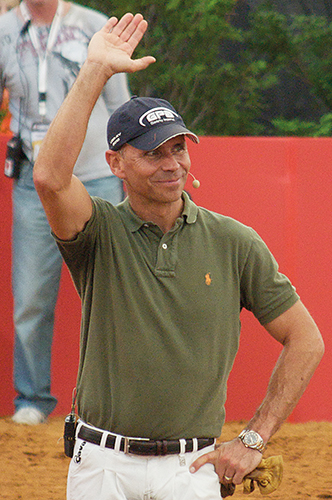 Story – Chris Hector & Photos – Roz Neave and Travis Cole
Story – Chris Hector & Photos – Roz Neave and Travis Cole
The crowd at Equitana presented a unique sort of challenge to any horse’s temperament, in that they are a study in perpetual motion, coming and going at seemingly random intervals. Jayden Brown’s imported 7 year old, Fürst Friedrich seemed to think it was pretty amazing, and Steffen was quick to note the horse’s reaction:
“How is he?”
“Love it. When you start working, especially with an energetic horse, give more rein, and be careful, if we create energy it must come from your leg, not so much from your seat. If you ride like that, using your seat, the judges will say it looks like hard work. Sit tall… there aren’t so many of us guys in the sport.”
And, no prizes for guessing, one of Steffen’s main themes in this session with Jayden is contact, and this time he is worried about a downhill tendency:
“It is perfectly fine to relax the horse in a lower neck position, but we don’t want to end up with contact with a downhill tendency. Only lower his neck if there is a real necessity. He takes too much contact and he presses down. When the contact is too low it becomes tricky…”
“It is all about self carriage and the best quality of the gait.”
more follows
Steffen has noticed the gelding’s tendency to hold himself back, and not really go with the flow:
“We can use collection but in between, you must allow him to go. When you increase engagement, you have to increase suppleness. Never accept increased engagement and expression if the horse stiffens.”
Wow, I suggest you go back and re-read that last sentence a few times.
more follows below
“Increase collection, increase suppleness, make him lighter when you engage him. If you don’t ask for suppleness, the horse will not be supple. Forward energy is great, but don’t let forward energy work against you.”
“I appreciate that you go forward but you must come back just as easily.”
“Let’s be more colourful, don’t always ride in a grey area, let them enjoy.”
Still Steffen was worried by the tendency to over-use the seat:
“Ride respectfully forward, and allow. Forward not with your seat, just close the leg. It is so important to have adjustability in tempo. Riding with control, that’s a huge benefit. You horse needs to learn to really wait, it’s learning to control the forward tempo. It’s hard for him in trot, let’s try it in canter.”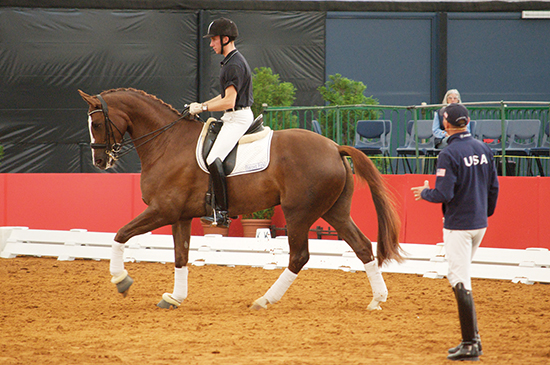
In canter, Jayden’s horse was really not going forward…
“We know he can collect, ride him forward but control the tempo. Control the neck, it is not up to him to lower, it is up to you to decide you want him lower. When you lengthen, why go downhill? Up hill – up, up, up and go.”
And go they did.
“Great, pat him, get out of the grey zone into the black and white zone. Perfect, pat and tell him, he did it right.”
“Learning brake pedal with an engaged hind leg, that’s what he has to learn, and he has to stay up there. He takes advantage of longer and lower, don’t let him. You want to step forward, he says ‘okay’ but he is going on the forehand and pulling. It’s the same when you go posting trot, it doesn’t mean drop the neck. He doesn’t really accept the contact, his tendency is to go evasively down. It is easy to say ‘more forward’ but is it controlled? Don’t let the length of his neck be an evasion, don’t let him use his muscles against you.”
“This is a wonderful, talented horse. You need energy for Grand Prix, but you need to channel that energy. And don’t create more energy with your seat. It is tempting, but don’t do it.”
Steffen works with another horse, scroll down
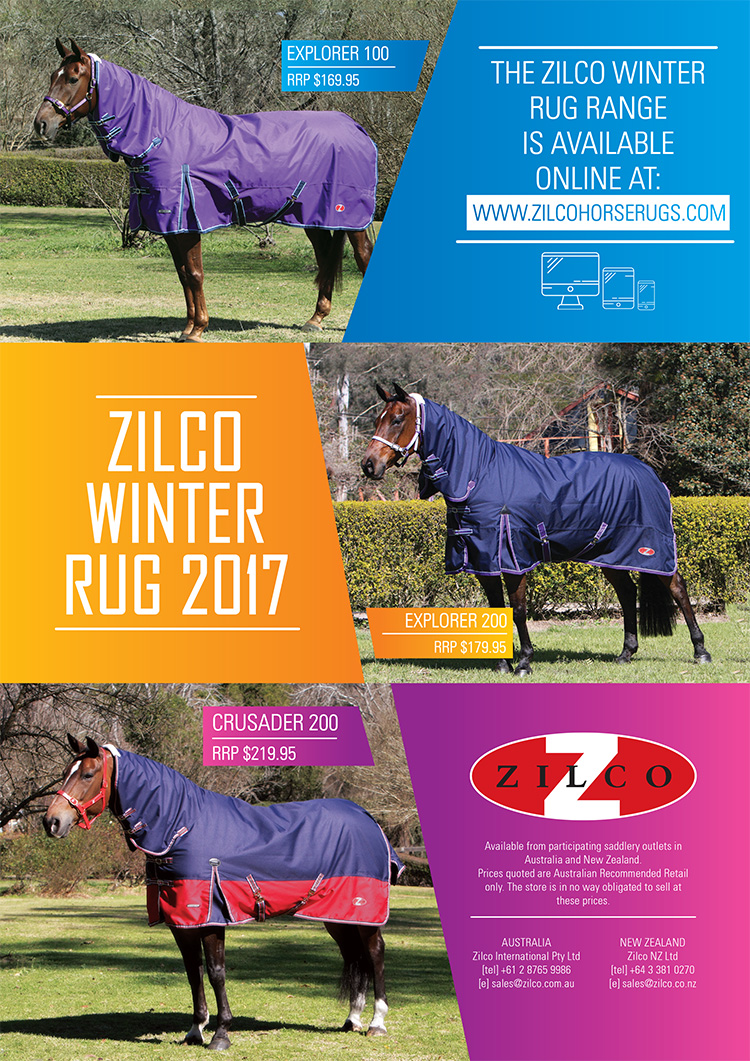
https://goo.gl/mY2Zq4 For a stockist of the Zilco Range near you
Steffen found very similar issues with the next horse, Yarra Valley Rodrigo – a locally bred gelding, by Regardez Moi out of a Flemmingh mare, ridden by Justine Greer. “Think about the length of the frame, the length of the neck, be clear that the horse doesn’t use this in an evasive, disrespectful way. Everyone talks about having a long neck, it’s great if you can control it.”
And the control / contact issues began, even before the horse took a step:
“The contact was heavy in the halt so it will be heavy when he goes forward. Teach him in halt to stay with you, it’s like teaching a puppy to heel.”
“Everyone says ‘engage the hind legs and the horse will stay light’ – sorry, you have to teach respectful contact, you have to teach the highest standards of connection. When you go to halt and he pushes his nose out, that is an attention issue.”
Time to trot:
“Why downhill? Why low in the neck? We as riders have to take responsibility. Tap when he dives like that, there are so many opportunities to tap. Yes, you want forward but it all ended up in your hand. Create awareness because without awareness you cannot stay in light self carriage. I love a steady hand but if you don’t ask for suppleness, the horse won’t be supple. A steady hand can be a creative hand.”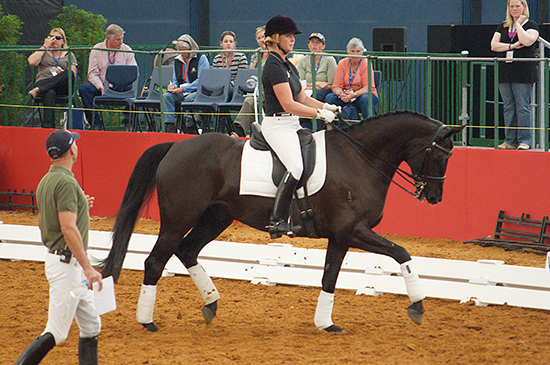
Again Steffen emphasizes that it is not about riding the movements but how you ride the movements:
“Test the movement, don’t just ride it hoping things turn out right. You are still thinking about the movement and not about the feeling underneath you. It might look good but if it doesn’t feel honest, you need to do something. You are the trainer. It’s about thinking about the basics, is my horse carrying himself? Is he in front of the leg? Is he into the bridle. Train don’t just ride movements, if it doesn’t feel effortless, I guarantee it doesn’t look effortless.”
Steffen returned to one of his ongoing themes – the tendency to kick.
“If you kick, the canter stride just gets quicker, we don’t want quicker, we want to cover ground. Use the spur for two strides, don’t just kick one stride, hold your leg for two strides, get his attention, get the reaction – close and hold for two strides.”
And again and again, Steffen stressed that it wasn’t a matter of riding the different movements of the dressage test, but the quality of those movements:
“Don’t accept the movement when the horse is not awake. You are doing a wonderful job teaching the movements, but the question you must ask every stride is, is it honest? You have so many tools to use, don’t just ride the movements – work on energy and self carriage. Every movement in the dressage test is just a test of energy, suppleness and self-carriage.”
“Now it looks effortless, and that is what the sport is all about…”
Working with Jenny Gehke and her imported mare, Gitane, Steffen again demonstrated his insistence that every detail be correct, every step the best possible in the situation…
“When your mare is a little nervous in the walk, she jigs, she is running through the bridle. What to do? Halt. Stop. Then be very picky with the first step of walk. Halt nicely uphill. It is important to be adjustable in halt without the horse going forwards or backwards.”
“Now ride her more uphill. Most people when they think uphill, think shorter reins – no. Ride her uphill, when she dives, bring it to her attention, ride her uphill not downhill and maintain a consistent frame.”
“Do you mind if I ride her?”
I guess we knew the answer to that one.
Next Steffen rides Jenny’s horse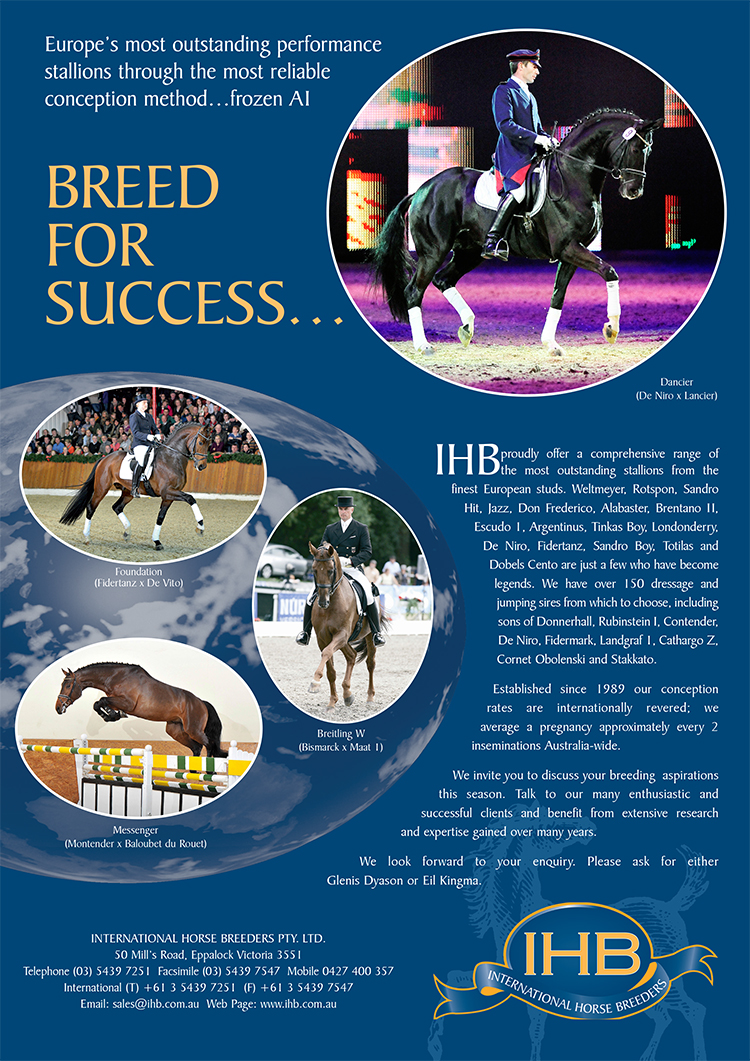
“The whole idea of riding the horse over the back, deep and round, is 100% necessary if the horse develops an under neck, if the horse it going against us, but she is strong enough in the back to ride her a little uphill. Her first step forward is a little against the bridle. That is not okay. Tap, do it again. Don’t let her lean on the curb, the curb makes them too round. Engage her hind leg and mind as well, and make it clear to her that we won’t accept the nose dive.”
“Her first tendency is to go forward and downhill. She must be respectful when she goes forward, she tricks us into too much contact, then the half halt doesn’t go through. When she goes forward there is no need to be a bulldozer, she can be a dressage horse. She must accept the engagement of the hind leg with lightness. She tricks you into struggling rather than saying, ‘no sister, you are not running through the bridle.”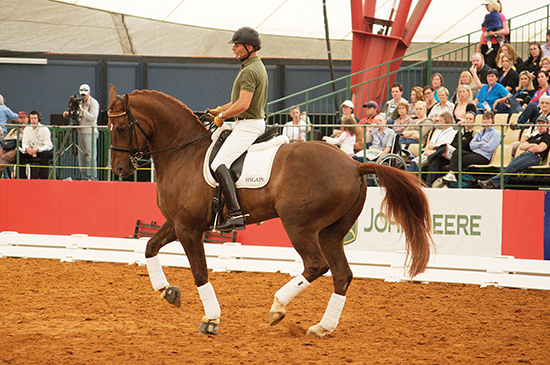
Steffen is riding a few piaffe steps”
“I am reminding, not supporting. Train them to offer the movement. Give her the opportunity to figure this out but refuse to give her too much spur.”
Jenny is back in the saddle and riding pirouette.
“Ride pirouette to the right, testing the movement, don’t just ride it. Is it honest? Is it true? Is it controllable?”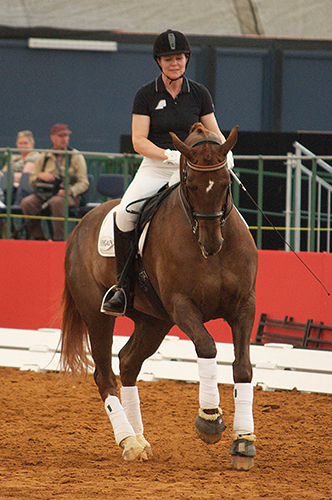
It was Jenny’s turn to ride piaffe:
“You are riding as if you are teaching her piaffe. You’ve already done that, don’t help her. The half halt is such a mystery after all these years. What is important is the result.”
Next, Steffen works with Maree Tomkinson and Diamantina and Mary Hanna and Sancette – and has a ride on Shiraz Black…
Want more of Steffen’s wisdom? Go to his Who’s who entry to find all his articles, lots of articles…



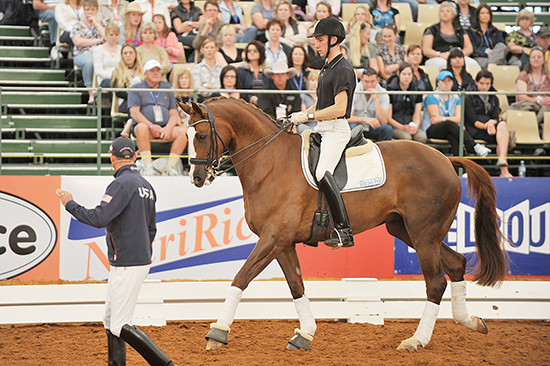

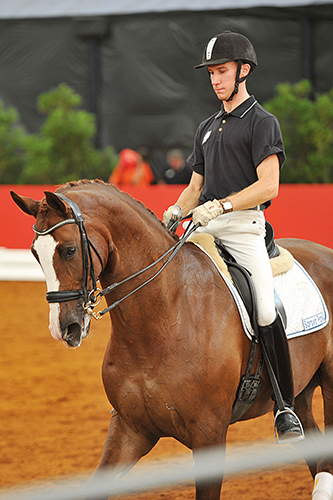
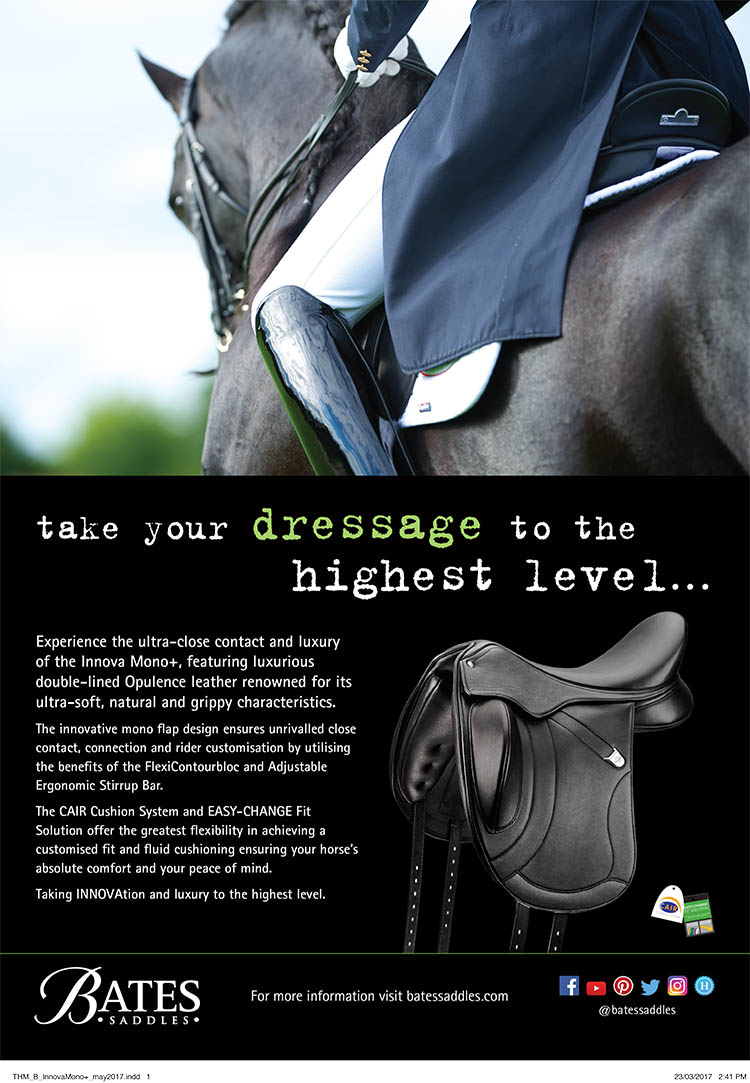
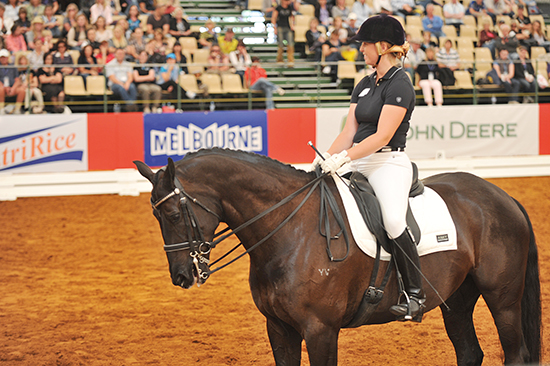
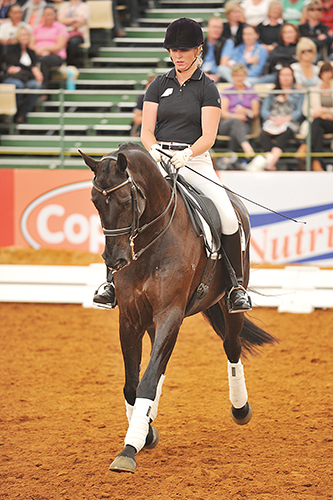
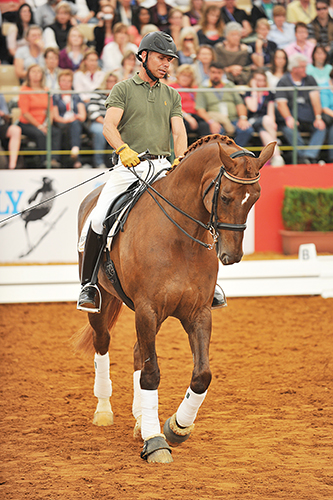
Great writing. Great article. I almost feel I was there.
Thank you.